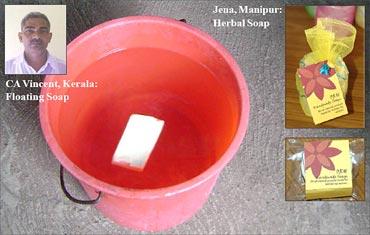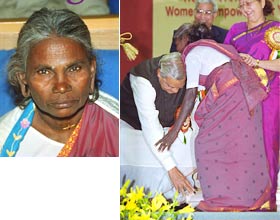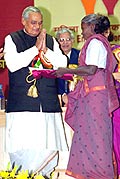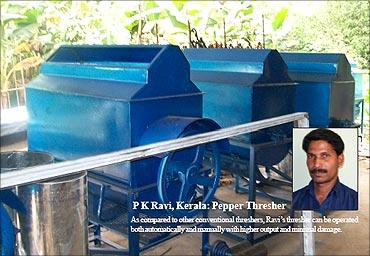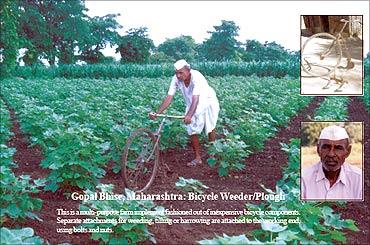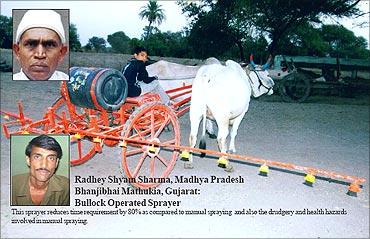
Palani has been mentioned in the Tamil Sangam Literature as Podhini, which came to be called as Palani later, according to the historions. In ;Thirumurukatruppadai ( a Sangam Literature ) Palani has been mentioned as the 3rd PadaiVeedu. This was the southern end of the Kongu Nadu and edicts refer to this place as Vaiyapuri Nadu , which was ruled by king Vaiyapuri Kopperumbaegan. Many Siddhas; are said to have lived in this region. The idol of Palani Andavar is said to have been made of Navapashanam ( a combination of Veeram, Pooram, Rasam, Jathilingam, Kandagam, Gauri Pasanam, Vellai Pasanam, Mridharsingh, Silasat), by a siddhar called Bhogar. It is also claimed by many that the materials of abhishegam like milk, sandalpaste, etc., attain medicinal properties on being poured over Lord Palaniandavars idol and they have cured many diseases, when taken by the patients. It is a speciality of Palani.

PALANI STHALAPURANAM
The History of Palani written by Balasubramania Kavirayar speaks about the glory of this place. This contains 23 chapters in 987 verses, and was written in 1628AD. The Temple Office has released a new and revised book in 1998.
The story of Lord Muruga, why He left Kailasa and came to Palani, and how Palani got its name.Lord Siva and Goddess Parvathi are seated atop Mount Kailas. One day, Lord Narada comes and gifts them a celestial fruit. The two sons of Lord Siva, namely Ganapathy and Murugan, demand the entire fruit for each of them. Siva announces a competition and promises to give the fruit to the one who wins the test. The condition is they should go round the world and reach back first. Both agree to it and Ganapathy makes a circumambulation of His parents, reaches first, and wins the fruit. Murugan who goes on his peacock around the world reaches later and finds that Ganapathy has won the prize. He therefore gets disappointed and, renouncing the world, stands atop the Palani Hill. Siva and Parvathi come to Palani and pacifies Murugan telling him Muruga, you are yourself a divine fruit ; then why do you need a fruit? Fruit, in Tamil, is called Pazham. Hence this place came to be called as Palani, as Muruga was addressed as Palam Nee. Some say that Palani got its name from Pazhanam (meaning paddy fields )
Kavadi : How kavadi tradition came to palani?
Sage Agastya wanted to take two hills — Sivagiri and Sakthigiri to his abode in the South and commissioned his disciple Idumban to carry them. Idumban bore the hills slung across his shoulders, in the form of a kavadi one on either side. When he was fatigued, he placed the kavadi near Palani to take rest. At this stage, Subrahmanya or Muruga had been outwitted in a contest for going round the world. Ganapati had won the prized fruit (pomegranate or mango) by simply going round His parents. Long after, this, Subrahmanya came sweating on His peacock to find that the prize had already been given away. In anger, the frustrated child left the divine parents and came down to Tiru Avinankudi at the Adivaram (pronounced Adivâram. It means foot of the Sivagiri Hill). Siva pacified Him by saying that He (Subrahmanya) Himself was the fruit (pazham) of all wisdom and knowledge; neeyou. Hence the place was called 'Pazham Nee' or Palani.
Later, He withdrew to the hill and settled there as a recluse in peace and solitude. When Idumban resumed his journey, he could not lift the hill. Muruga had made it impossible for Idumban to make it. In the fierce battle that ensued, Idumban was killed but was later on restored to life. Idumban prayed that: whosoever carried on his shoulders the Kavadi, signifying the two hills and visited the temple on a vow, should be blessed and he should be given the privilege of standing sentinel at the entrance to the hill. Hence we have the Idumban shrine halfway up the hill where every pilgrim is expected to offer obeisance to Idumban before entering the temple of Dandâyudhapani. Since then, pilgrims to Palani bring their offerings on their shoulders in a kavadi. The custom has spread from Palani to all Muruga shrines worldwide.
Temple An Oceanic Life Story

Bogar is a Siddhar, he is considered as one of the 18 siddhars born in the world. According to epigraphical sources and his book Bogar Seven thousand his period is around 3000 B.C. Bogar born at India and visited China in search of truth of life, he gained knowledge in medicine, astrology, spritiuality, yoga etc. Bogar anticipating that in due course of period, human beings will suffer from large number of disease. As an expert in medicine he used 4448 rare herbs and made 9 poisonous medicine, mixing these 9 poisons into one needs great knowledege and skill, to make a Master Medicine ( One medicine to cure all disease ). Thirumoolar also discuss one such Master Medicine in his book Thiru Mandiram. With the consultation of Agasthiar ( Father of Ayurvedic Medicine) and other siddhars Bogar mixed the 9 poisons ( Nava Bashanam ) and made the Master Medicine in the form of Lord Murugan which is currently worshiped at Palani Murugan temple. There is a place near Palani Hill called Thanasiappan Temple which is the place were Bogar mixed the Nava Bashanam and made the Murugan idol.
Bogar and others then decided that by using the milk and panchamirtham ( a sweet recipe ) poured on the idol, one can extract the medicine from the idol. The milk and panchamritham then becomes medicine to cure disease. After installing Lord Murugan Navabashana idol at the Palani Hill, Bogar used to worship it with milk abishegam ( pouring milk on the idol ) and panchamirtha abishegam ( pouring panchamirtham on the idol ). His disciple Pulipani siddhar then took over the job of Lord Murugan pooja after Bogar went into Nirvigalpa Samadhi - the highest samadhi stage; where the Mind dissolves with Matter and Energy.
Bogar Samadhi is inside Palani Murugan temple at Palani Hill. Actually Bogar himself constructed his samadhi exactly under the Lord Murugan Navabasha idol and went into Nirvigalpa Samadhi there. The entrance to his samadhi is a cave like structure, now also worship for this great siddhar is conducted at this entrance where he is last seen by his disciples which is at the Palani temple.
Navapashanam : The icon made by siddha Bhogar by combining nine poisonous substances (Navapashanam).

Palani-Geoghraphical Location:
India is a land of spirituality, with the vast and fertile Ganges plateau. Spanning 3214 KM south-north and 2933 KM east- west, it has an area of 32,80483sq.km.The beautiful state of Tamil Nadu is situated is the Southern region of India, with Chennai as its Capital. Palani town is 472 KM away from Chennai. It has area of 6.63Sq.KM and is located at 10.3 N and 77.3 E of the meridian. It is about 309-323 m above sea level, and has a rainfall of 560mm annually. Getting rain by the North-East Monsoon, this town is situated 10 KM away from the range of the Western Ghats on the South, called the Palani Hills. Kodaikanal a famous tourist township is situated and these hills, at a height of 2133 M. The Shanmuga River (consisting of Palar, Porundalar, Varadhamanadhi, Pachaiyar, Kallar and Kanar) flows from these hills and is 3KM away from Palani. Its length is 19KM .Palanis temperature is 22 c - 35 c. Details of the Palani Hills The Palani Hills, famous in the Sangam Literature, has a height of 160 Meters. It has a path around it, admeasuring 2.84 KM. The Hill has 689 steps to reach the top, and is surrounded by various medicinal herbs and trees like Sandalwood ,Kadamba, etc., as also fields and groves. Important places around Palani Kodaikanal, the Queen of the south Indian Hills is situated near Palani and is an import tourist centre.
Perianayagi Amman temple, Periyavudaiyar temple, Dams at Palani Porundalaar, the garden of herbs etc., situated in an area of about 7KM radius around Palani. The Kurinji Andavar temple at Kodaikkanal is a famous shrine. There is a temple for Lord Muruga at Poomparai. The Kurinji plant which blossoms once in 12 years is seen in this area. Location of Palani The Palani temple is considered to be the foremost among Murugan temples of Tamil Nadu. Thousands of devotees come and worship here throughout the year. Apart from the people of Tamil Nadu, those from Andra , Karnataka, Kerala, etc., also come from large numbers and worship here. So the temple here always has a festival look. Lord Gnanadandayudhapani, in the form of Guru, showers his grace on the devotees. This place is situated at a distance of 56 KM from Dindigul, 472 KM from Chennai, 114 KM from Madurai, 103 KM from Coimbatore, 126 KM from Erode and 156 KM from Trichy.
Kodaikkanal is 64 KM away on the South of Palani. There is train facility to reach Palani from all the above places, except Kodikkanal, which can be reached by bus or car. As the above towns have air travel facility, visitors can reach Palani by car after reaching the above town by air from elsewhere.
Archaeological Details :The Palani Hill temple has been constructed on the top of a hill. It is said that the temple was built by a Chera King.
The Palani Hill temple has been constructed on the top of a hill. It is said that the temple was built by a Chera King.
1. EDICTS
On the outer walls of Lord Murugas shrine there are many edicts, made by some Pandya Kings, Sadayavarman sundarapandiyan, Sadayavarman veerapandian, Veera Nanjana wudaiyar , Mallikarjuna Devarayar II and others. The edict by Sundarapandiyan is the oldest of all. He was also Known as Kongupandiyan and was the famous king of the later Pandya Dynasty . He ascended the throne in 1251 AD. From the inscriptions on the wall, he come to know that many kings have gifted lands and villages to the temple to enable the conduct of regular Poojas. In 1300 AD king Jatavarman sundrapandian gifted a village for carrying a special daily Pooja in his name. It is called Avani Vendha Raman Sandhi.2. SCULPTURE AT THE HILL TEMPLE:

In the front Mandapam of the temple there are many beautiful and artistic sculpture pieces live Siddhas in penance, parrot, peacock, deer, Karpaga vriksha (Divine Tree ) and so on. There are also icons of Dhandayuthapani. His devotees, as also Yaali . At the entrance near the Raja Gopuram there are two nice sculpture pieces - a young lady carrying her child in the right arm and carrying a flower basket in the left; another beautiful lady , the friend of the first standing in front of her. There are pillars with Yaali in the Paaravel Mandapam. In the Ardha Mandapam there are sculptures of young, good looking damsels. They create a sense of admiration in the minds of the visitors. The Tamils belive that Murugan resides where there is beauty. The Sanctum of Dhandayuthapani Swami is full of art-work. The ceiling here having the Kodungai design speaks of the talent of the sculptors. The balcony - like structure on the outer side of this area adds beauty. Such artistic work can be seen on the pillars of Thiruvavinankudi temple and Periyanayagiamman temple. In the Navaranga Mandapam here there are two pieces the divine dance of Lord Siva and (opposite to this ) the dance of Kali after her shedding her ego .
3. PAINTING:
In the temple walls of Periyanayaki Ammam Temple there is a beautiful ancient painting, revealing the art of singers, artists and dancers. It belongs to the Nayak period.4. ANCIENT COINS :
In Palani area , old coins of ancient kingdoms were also found.The Glory of Palani :
The ancient Palani is a sacred place, praised by Saint Arunagirinathar in his Thiruppugazh and in Kandar Alankaram.The ancientPalani is a sacred place, praised by Saint Arunagirinathar in his Thiruppugazh and in Kandar Alankaram. He says: Adored by the people of fourteen worlds, the Lord resides atop the Palani Hills In the Thiruppugazh, he praised this place as Palani that is greater than Kasi and as Palani Hill that has many miracles. He also feels sorry for his failure to start early worship of Palani. In Kandar Alankaram he regrets that he missed reading about Palani, worshipping at the feet of Muruga Devotees, calling the divine name of Muruga, offering charities and sobbing with love and joy He doubts whether there is any salvation for him. Many Tamil saints and scholars have sung in praise of the Lord of Palani.
For example: Arunagirinathar has sung 97 songs (Thiruppugazh): Dhandapani swamigal has given as Palani Thiruvayiram and Vijayagiri Velachinnavaiyam Palani Pillai Tamil . Palani Malai Vadivelar Sannadhimurai speaks of the discipline of Palani worship, the good results of this , the sacred ponds of Palani, and the Kavadi offered here. It points out the great benefits, as also the sure remedy for many ailments of the people. PLACES OF THEERTHAM Saravana poigai, near Thiruvavinangudi, and the Shanmuga River are the sacred water- sources of Palani, where the devotees bathe before worshipping at the Temple. TEMPLE TIMINGS The temple is open on all days from 6 AM to 8-30 PM. On Krithigai and other festival days it opens at 4 AM. Without any fee, all can have dharsan here.
Vallisunai:

In the Hill temple, Valli sunai considered to be the most ancient and holiest, was not properly cleaned for the part 15 Years. The Sunai was cleaned (for more then 10 days) and transformed into a cleaned Holy Sunai.

